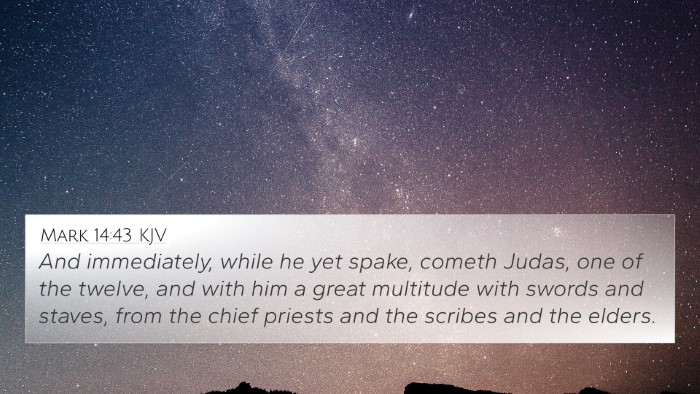Understanding Matthew 26:47
Matthew 26:47 recounts the moment when Judas Iscariot arrives with a multitude to betray Jesus. This pivotal event highlights themes of betrayal, loyalty, and the fulfillment of prophecy within the broader narrative of the Gospel.
Verse Text
Matthew 26:47 (KJV): "And while he yet spake, lo, Judas, one of the twelve, came, and with him a great multitude with swords and staves, from the chief priests and elders of the people."
Commentary Insights
Various public domain commentaries provide profound insights into the meaning of this verse:
-
Matthew Henry:
Matthew Henry emphasizes the gravity of Judas's betrayal, indicating that it was a deliberate act against the Son of God. He notes how Judas, one of the chosen twelve apostles, succumbed to greed and treachery, illustrating the depths of sin that can manifest even among the closest followers of Christ. Henry points out the larger context: the multitude's arrival signals a turning point leading to Jesus' crucifixion, which fulfills scriptural prophecies.
-
Albert Barnes:
Barnes discusses the emotional weight of the betrayal, noting the contrast between the intimate relationship Judas shared with Jesus and his subsequent act of treachery. He highlights that the multitudes wielded swords and staves, indicating the severity of their intent and the perceived threat Jesus posed to the religious authorities. This verse connects to larger themes within the passion narrative, illustrating the confrontations between Jesus and the Jewish leaders.
-
Adam Clarke:
Clarke provides a historical perspective on Judas's actions and the context of the multitude's approach, suggesting that their presence represents a culmination of the chief priests and elders' conspiracy against Jesus. He further explains how this event marks the culmination of many Old Testament prophecies about the Messiah’s suffering, reinforcing the sovereignty of God in the plan of redemption.
Thematic Connections
This verse can be connected to several broader themes and other scripture passages that enhance understanding through cross-referencing. Here are some related Bible verses:
- John 13:21: "When Jesus had said these things, he was troubled in spirit, and testified, 'Truly, truly, I say to you, one of you will betray me.'
- Psalm 41:9: "Even my close friend in whom I trusted, who ate my bread, has lifted his heel against me."
- Matthew 26:56: "But all this has taken place that the Scriptures of the prophets might be fulfilled." This verse reiterates the idea that betrayal is part of God's plan.
- Luke 22:48: "But Jesus said to him, 'Judas, would you betray the Son of Man with a kiss?'
- Zechariah 11:12: "And I said to them, 'If it seems good to you, give me my wages; but if not, keep them.' And they weighed out as my wages thirty pieces of silver."
- Acts 1:16: "Brothers, the Scripture had to be fulfilled, which the Holy Spirit spoke beforehand by the mouth of David concerning Judas, who became a guide to those who arrested Jesus."
- Matthew 20:18: "See, we are going up to Jerusalem, and the Son of Man will be delivered over to the chief priests and scribes." This offers insight into Jesus' foreknowledge of His betrayal.
Conclusion
The events surrounding Matthew 26:47 are not isolated; they are interconnected within the fabric of scripture. By understanding the connections between Bible verses, we see a richer picture of God's redemptive plan and the roles individuals play within it. This verse invites reflection on themes of loyalty, betrayal, and the unfolding of divine prophecy.
Exploring Further
For those seeking deeper insights, utilizing tools for Bible cross-referencing is essential. Understanding how to find cross-references in the Bible can enrich personal study or sermon preparation. Techniques such as cursory readings of the Gospels, utilization of a Bible concordance, and engaging in comparative studies can reveal the intricate web of connections between Bible verses.








